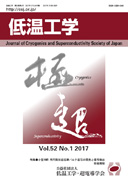
- Issue 6 Pages 381-
- Issue 5 Pages 313-
- Issue 4 Pages 209-
- Issue 3 Pages 133-
- Issue 2 Pages 77-
- Issue 1 Pages 1-
- |<
- <
- 1
- >
- >|
-
Mitsuho FURUSE2017Volume 52Issue 3 Pages 133
Published: May 20, 2017
Released on J-STAGE: June 01, 2017
JOURNAL FREE ACCESSDownload PDF (602K)
-
Norihito OHUCHI, Tatsushi NAKAMOTO2017Volume 52Issue 3 Pages 140
Published: May 20, 2017
Released on J-STAGE: June 01, 2017
JOURNAL FREE ACCESSDownload PDF (536K)
-
Tatsushi NAKAMOTO2017Volume 52Issue 3 Pages 141-148
Published: May 20, 2017
Released on J-STAGE: June 01, 2017
JOURNAL FREE ACCESSWhile the LHC accelerator at CERN has been operating smoothly, the High-Luminosity LHC (HL-LHC) Upgrade Project, which has aimed at attaining a total integrated luminosity of 3000 fb-1 for about 10 years—a factor tenfold the design value of the present LHC—was planned in order to improve the statistical precision of physics results. To realize this ambitious target, a full upgrade of accelerator elements in the insertion regions for the ATLAS and CMS experiments is crucial. In particular, large-aperture superconducting magnets with a higher field and superconducting RF crab cavities hold the key to the success of the project. In this article, an overview of the HL-LHC and its relevant R&D efforts are introduced.
View full abstractDownload PDF (2560K) -
Michinaka SUGANO2017Volume 52Issue 3 Pages 149-156
Published: May 20, 2017
Released on J-STAGE: June 01, 2017
JOURNAL FREE ACCESSThe large-aperture beam separation dipole (D1 magnet) needs to be developed for the high luminosity upgrade of the Large Hadron Collider (HL-LHC) at CERN. This magnet requires a field integral of 35 T·m at 12.0 kA and 1.9 K with a coil aperture of 150 mm. The technical challenges are controlling the pre-stress of the thin coils, achieving high radiation resistance and managing the iron saturation. In the framework of CERN-KEK collaboration, KEK is in charge of developing the D1 magnet and has been conducting design studies since 2011. A design including a single-layer coil based on Nb-Ti technology with a collared yoke structure was selected and fabrication of the first 2-m model started in 2015. In this paper, the overview and design studies of the D1 magnet are first introduced. Then, fabrication and test results of the first 2-m model are reported. Finally, future perspectives for the D1 production magnets are described.
View full abstractDownload PDF (2223K)
-
Atsushi ISHIYAMA2017Volume 52Issue 3 Pages 157-158
Published: May 20, 2017
Released on J-STAGE: June 01, 2017
JOURNAL FREE ACCESSDownload PDF (1037K)
- |<
- <
- 1
- >
- >|